I wonder where I am? I am not sure. The earliest morning light hits the hills and last few buildings of a town a few kilometers in beyond the wake of this expedition ship. Beyond that town I can see more ocean turn up North to the right which can only mean one thing: I am finally, going to see the South Coast of Newfoundland, up close, for the first time. A dream come true. A phrase I’ve uttered more than once in the last week.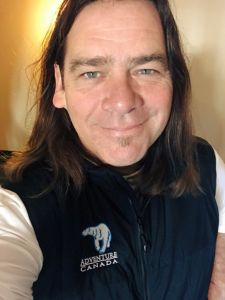
It is Day 7 of 10 aboard this vessel with 198 guests sailing with Adventure Canada, an expedition cruise outfit that specializes in Northern and Polar type trips in places like Iceland, Greenland, and Newfoundland. I am one of about a dozen Cultural Hosts, a team of musicians, authors, historians, naturalists, geologists, photographers and film makers who are responsible to share information, experiences, songs, and stories while guiding guests around the Province. I’ve wanted to sail around the perimeter of my Island home for most of my adult life. I assumed that the opportunity to get on a ship in St. John’s and sail around the Island right back into the St. John’s would give me greater understanding of our coastal towns and indeed our entire island’s place in the greater world. Even with close to a third of the trip still ahead of me, I can tell you this has been one of the most meaningful weeks of my life. This morning is really the opportunity I’ve had to reflect on this incredible opportunity and to write a little bit about it.
Shortly after sunset on October 2 we sailed out the narrows of St. John’s. This, alone, was a moment I have dreamed of experiencing for a long, long time. As you likely know, I’ve left St. John’s on airplanes and in cars and vans for extended trips away, hundreds, if not thousands of times. But this place was settled by sailors and I have always wanted to join the history of people who left St. John’s for a journey by the original route in and out of town, waving to people on the shore as the light of the city disappeared over the retreating horizon.
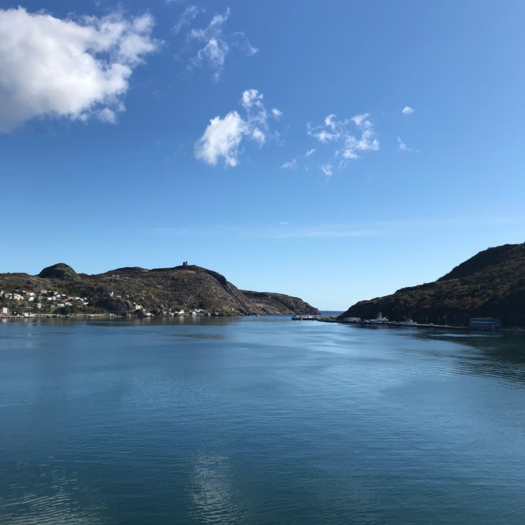
As the dusk drifted into darkness, I waved and shouted to my wife and son as they came to see me off from the cliffs of Signal Hill. I can’t wait to experience the same thing in reverse for the homecoming in a few days’ time.
The following dawn found the ship anchored (I confess I typed ‘parked’ twice and deleted it… so much for the myth of my seaworthiness) just off Bonavista. I’m happy to report this is one of the outport towns of Newfoundland that seems to have survived the cod moratorium as it has enjoyed a booming resurgence in recent years. I had a few days there in August and was delighted to see the fish plant busy with boats coming and going and the downtown’s main street bustling with locals and tourists hurrying in and out of the many shops and businesses.
I would come to learn that the patrons and crew of this ship are transported ashore in zodiacs, (the inflatable or ‘blowy-upy’ small boats as I called them, to the bemusement of the real sailors). The host team go ashore first and set up a receiving area for the guests and organize any busses or entrance requirements to local museums or trails or whatever the day wants done. On this morning I stepped into a Zodiac just after dawn as the first morning light lit the historic wooden buildings and colourful fishing boats along the wharf and basin.

There was not so much as a breath of wind and the water was as calm as a clock. Sitting on the pontoon of the Zodiac was like sitting on a comfy couch as we floated over the mirror of the harbour. It was nothing short of magical and I figured this one Zodiac ride was reason enough to come on this trip.
I loaded a bus with 50 or so guests and was one of a few of the host team leading a group to Elliston, a few kilometres down the road. Elliston is known as a Root Cellar capital; some say of Newfoundland, some say of the world. Root cellars are shining example of how we used to do things way better than we do now. These sub terrain pantries were easily dug and maintained with a simple door or two, some rock walls, and a turf covered roof. In the winter climate like the one we enjoy here in Newfoundland, you could harvest root vegetables in the fall and they would last without spoiling for the entire winter. For the scientifically challenged, like me, the simple explanation is that the temperature and humidity inside the cellar is ideal for root vegetable storage no matter what the humidity and temperature outside. Just keep the doors closed and the food deep in the cellar safe from temperature swings and rodents and you can eat your own home grown produce all winter long. They use no electricity. They provide local vegetables to a winter climate without putting a single potato on a truck, ship, train, or plane. No carrots trucked from California. No potatoes shipped from Chile.
It is tough to look at a root cellar and not think, “Why did we ever stop doing that?”
Elliston is also known for beautifully restored historical buildings and a puffin colony that is as accessible as a Tim Hortons Drive-Thru.
And then there is the spectacular Sealers Museum and monument. Sealing was a necessity of life on this coast and it is almost inconceivable that any year-round sustainable human habitation could have happened here without the hunting of seals, seabirds, and caribou, or anything else they could find in the winter. Sealing was laborious and dangerous work and people risked their lives daily to feed their families and to earn some extremely rare cash money. There has been more than one tragedy on the ice as weather and ice conditions and a combination of all led to the loss of so many Newfoundlanders and Labradurians. The museum and monument in Elliston are both spectacular.
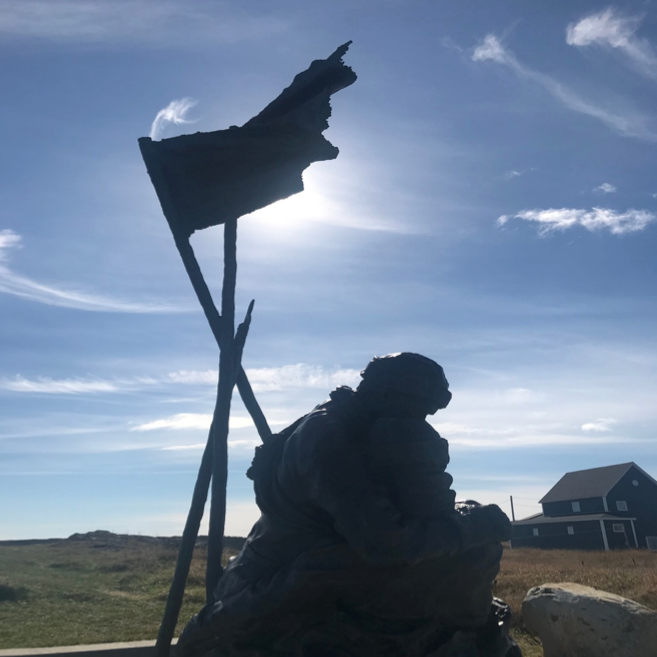
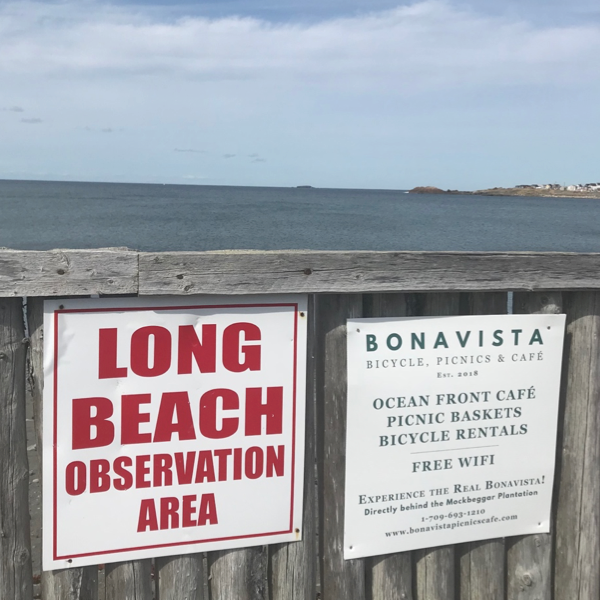
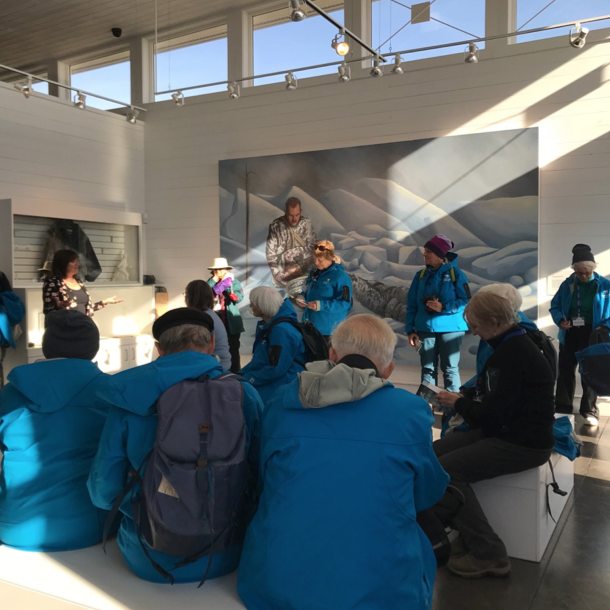
After a wonderful walk through the booming Bonavista, the statuesque Cape Bonavista Lighthouse and the Dungeon Park, it was back to the Ocean Endeavour for a few songs.
I tried to gear my performances aboard, both formal and informal, as closely tied to the trip as possible. So that night aboard the ship I performed Laying Down to Perish, a song of lost sealers, as an homage to the Elliston trip and Great Big Sea Hove in Long Beach, as Long Beach from the song is indeed in Bonavista.
The next morning, we ran into some heavy winds which meant we could not dock in Conche on the Northern Peninsula. I was most disappointed for sure as I’d always wanted to visit there, but what we got in return was a day that shall stay with me for quite some time.
We detoured into Little Bay Islands, a town that was once the North East Hub of the Newfoundland Cod Fishery, the Labrador Fishery and Sealing Industry. In its day, LBI had two massive fish plants, one for Fresh and Frozen Cod products and a second plant for Salted cod. It also had a large area of the town dedicated to the processing of seals. Two members of our host team hail from this town, which is all but fully resettled now. Tony Oxford and Gerry Strong had us all enthralled walking us though the hills and around the harbour and tickles explaining how this once boom town worked when they were kids. They spoke of constant activity and adventure working on the wharves and in boats and in the hills and on the frozen ice in the winter. Tales of Due Notes and sands from Africa and many more completely unsuspected stories had me curious and crying and laughing and loving every second of our visit. As we left, I could not help but lament the fact that this town, like so many on the coast of Newfoundland, live by a calendar whose days are numbered. You might not have many more chances to visit Little Bay Islands. So get on it straight away.
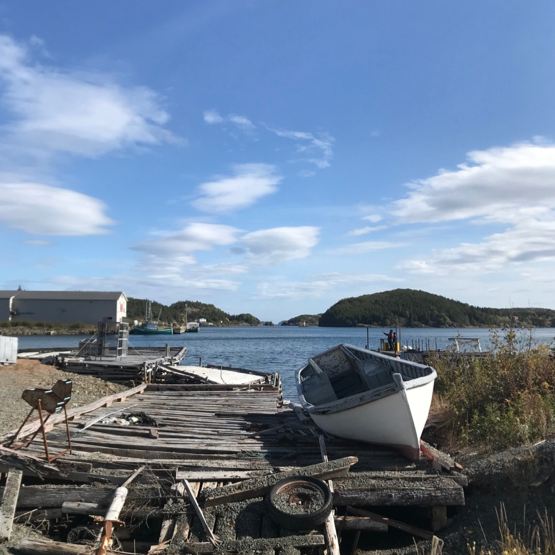
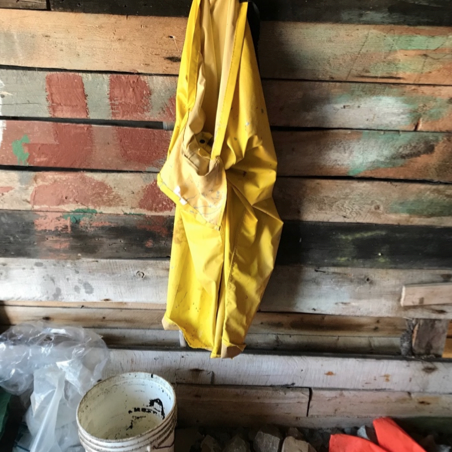
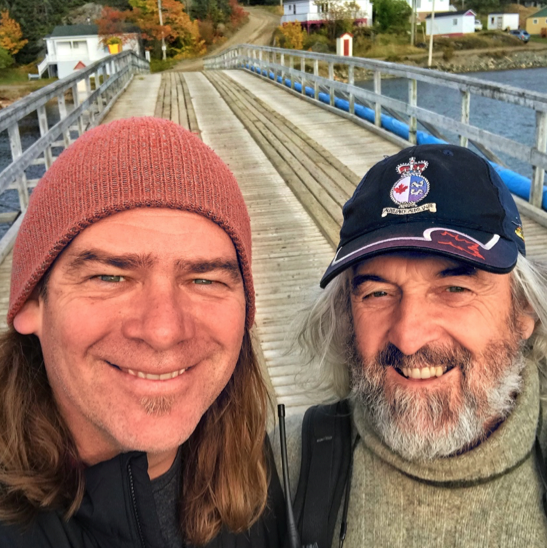 Pic with LBI’s own Tony Oxford on Shoal Tickle Bridge.
Pic with LBI’s own Tony Oxford on Shoal Tickle Bridge.
As many readers of this blog will know, I spent close to a decade of my life as a tour guide at The Newfoundland Museum. I turned 16 in May of 1985 and a wise teacher who had recently worked with the Department of Historic Resources explained that the museums and historic sites were looking for summer student tour guides and thought I, as a curious talkative kind of fella, might be good for the job. She got me an interview. I got the job. I started in late June of 1985 and did not leave until well after GBS started and was rolling into 1994. I loved it. I learned so much about Newfoundland and Labrador and got to meet so many people who were travelling to our province. I learned that I loved talking about our own backyard and showing people a good time in it. Two of the big exhibitions in the museum showed the Norse settlement in L’Anse Aux Meadows and the Basque Settlement in Red Bay Labrador.
I must have explained these two archaeological finds hundreds if not thousands of times in my years at the Museum. But I never got to see either of them in person. Not till the next two stops on the Adventure Canada trip.
We anchored just off St. Anthony (insistently pronounced Snatney locally) and after another beautiful zodiac experience, I took what I am embarrassed to confess were my first real steps on the Northern Peninsula of Newfoundland. St. Anthony is one of those places that proves you should see every harbour town from the water first. In all my years of longing to come here and asking people to describe it to me, I never once heard anyone say it is a spectacularly beautiful harbour and town. We drove around a bit later in the day and indeed, entering St. Anthony by road is nowhere near as wonderful as by sea. It’s just not the same thing at all. Other than the Harbour itself, St. Anthony is the home of the Sir Wilfred Grenfell Museum and house. I don’t have time or space here to fully explain the impact Dr. Grenfell had on this part of Newfoundland and Labrador as he tirelessly brought medical care and medicine to remote coastal towns for decades.
His commitment to care for the people in this area and the incredible effort it took to deliver it cannot be overstated. I have heard it argued that without Dr. Grenfell, the very settlement of this vast coast would have been questionable. I was thrilled to finally walk in the former home of a man who has inspired people from all over the world to do more for others. He is nothing short of inspirational.
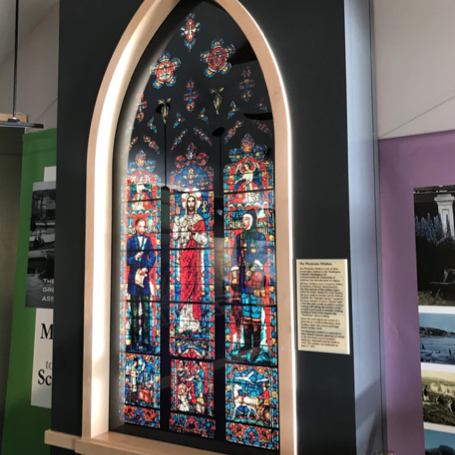
As cool as the St. Anthony visit was, I had my eyes set on seeing L’Anse Aux Meadows in person for the first time.
How I loved to tell the story of the discovery of this Norse site and was so delighted to hear the local experts confirm that it was indeed true. The story goes that a husband and wife team from Norway had hunted through ancient writings and sagas and suspected the language in them referred to some North American landing site that would pre-date Columbus by hundreds of years. The fact that this could disprove a long-accepted fact about Europeans first landing in the new world drove them to all ends of Europe and around the world in the hunt for the truth and any ruins to demonstrate the Norse were indeed in North America. After years of searching and a lifetime of academic pursuit, they arrived in L’Anse Aux Meadows and approached a local gent who introduced himself as George. George welcomed them and asked what brought them to this area. They felt like it might take a while to explain their unusual treasure hunt, so just simplified it and explained they were looking for ruins.
“Oh yes. The ruins are just over here, see. We used to play in them when we were kids.”
A few archaeological digs and a few key artifacts later and the Norse site at L’Anse Aux meadows would become one of the most significant finds in archaeological history. It proved that Columbus was well behind the Norse, by a long shot.
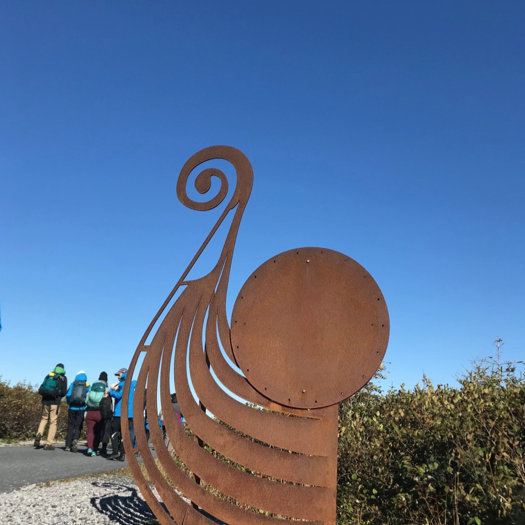
Finally seeing all this in person was a dream come true for this fella who talked about it for so many years at the museum. The site does not disappoint. Wicked visitor center and trails through the original dig as well as amazing recreations of the settlement. Highly recommended.
But there was yet one more special treat in store for me this day. One that perhaps takes a little explaining. I am a Canadian but was born on an Island off the coast of the country that was not part of that country when my parents were born. Also, I was born on the very east coast of that Island and all of the rest of Canada is far too the west of us. So, feeling a connecting to Canada as a first generation Canadian was difficult as my parents and grandparents knew little about it. Likewise, feeling a physical connection to Canada was almost impossible because I certainly had never seen any of it. Not from my Island, or more specifically, from my part of the Island.
But here on this day on the northernmost tip of our Island, I could do something I had never done before in my life– I could stand on Newfoundland and see the mainland of Canada. Might sound simplistic to some, but this was a bit of a moment for me. I’ve left this Island and crossed this country at least 20 times but could see one from the other. See that land in the distance behind me? That is the same land as Vancouver. Wild. Amazing. Well, to me anyway.

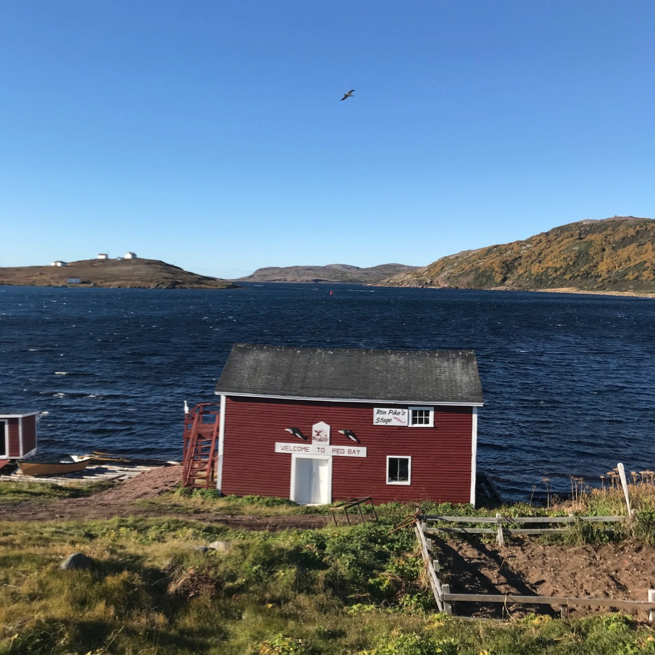
The next day we crossed the straights and visited another highlight of my many tours at the Museum. Red Bay Labrador is the site of a Basque Whaling station that again speaks volumes to early European settlement in North America.
The museums in Red Bay are wonderful (as was the Fish and Chips), but the best part for me was the hike around Saddle Island where the ruins of the Whaling Station can still be seen. The weather was perfect for such a walk and I was delighted to see the Ocean Endeavor bathed in sunlight as we rounded the back side of the Island. Hard not to feel lucky when this is your home for ten days.
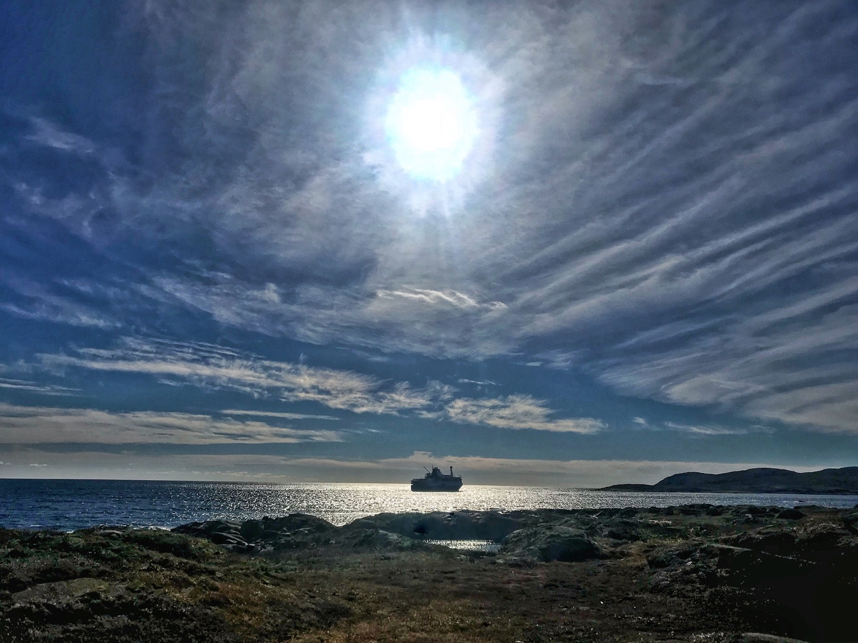
A long overnight sail brought us into Woody Point and Gros Mourne National Park.
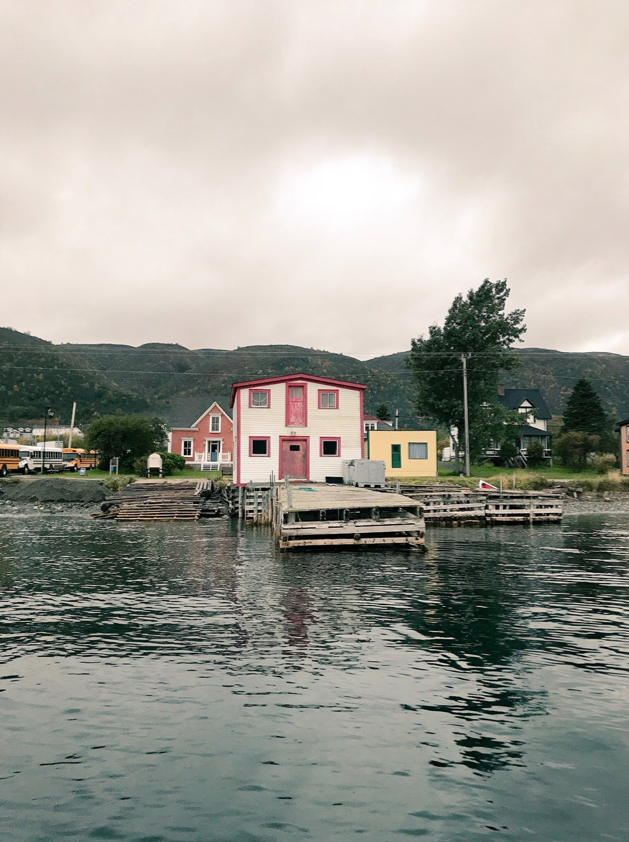
I’ve been lucky to spend many days in this wondrous place over the years at writers’ festivals and concerts and just as a fella climbing hills and hiking amongst geological landmarks. It was great to lead a group into the Tablelands as it was one of the only hikes in the park I had not yet done.
And that brings us to this morning. With a week of wonderful behind me, I’ve just watched the ship turn the corner and for the first time since we set sail, we are headed east, and in the home stretch. I’m longing for a day with my family in my own house on dry land, but there’s a few days of adventure left to find. And find them we shall on the South Coast.
To be continued.
Picking it up here a week or so since we made it Home.
Our first stop was really our only day in the uninhabited wilderness of Newfoundland. We sailed into La Poile Bay past the settlement of La Poile to a massive beach and cove. The idea was to give everyone a chance to see the untouched land for a day and what a day it was. It must have been near 20 degrees Celsius as we pushed the zodiacs up the sandy beach and started on a near ten kilometre hike up a hill without a real beaten path.
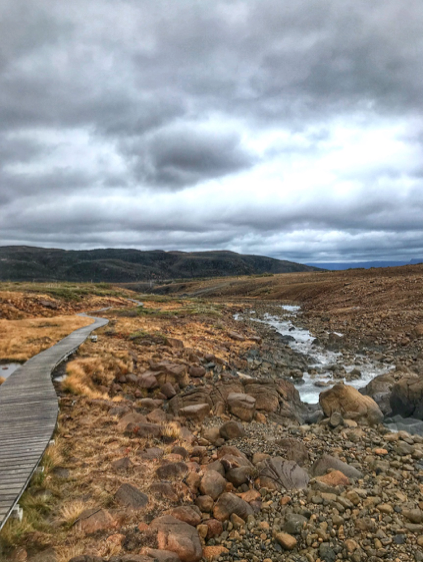
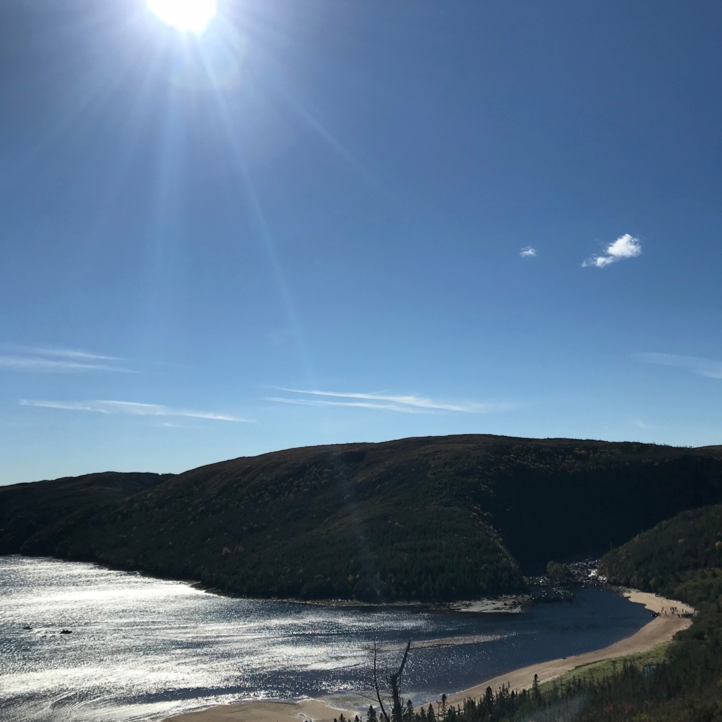
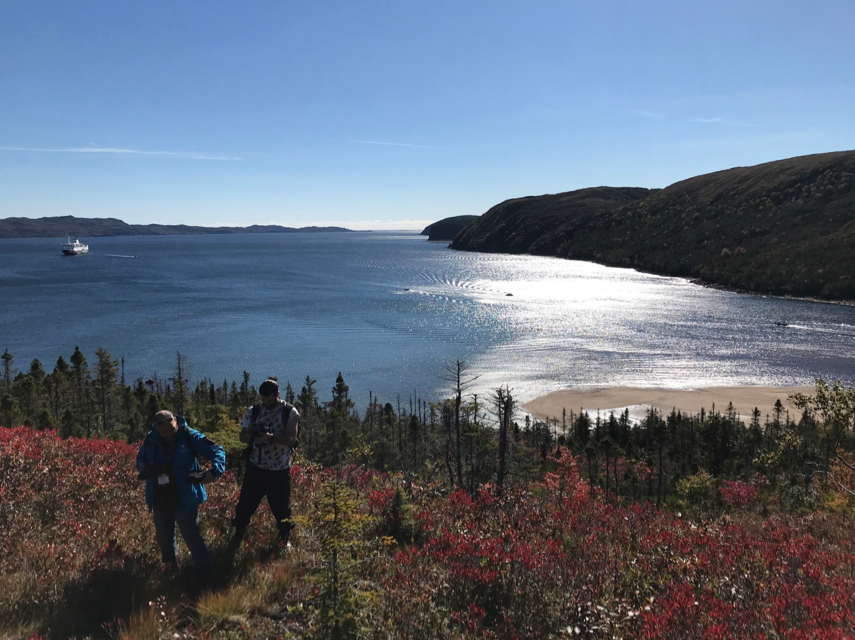
Over the next few hours, we scrambled and climbed and lifted and slid our way across some of the most remote parts of the Newfoundland coastline. It was special a day as I’ve ever had hiking anywhere. Steve, the real guide for the day put it best when he turned to us all and said, “Remember, you could very well be the first person to ever stand in the spot that you are standing right now.” I don’t know about you, but that has not happened to me very many times. It was a victory day, to say the least.
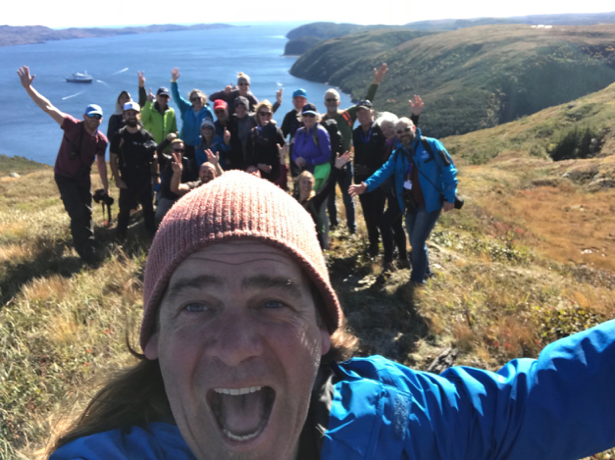
I woke early the next day because we were headed into Francois, pronounced Fran-sway by most locals. I saw old film footage from a TV documentary taken from the bow of a ship headed into the fjord that winds its way into Francois. It is jaw dropping to say the least and it has been a mission statement of mine for most of my adult life to see this site with my own eyes.
I won’t try to simulate the awe of the moment with my iPhone footage. It just would not begin to do it justice. Francois is nestled a kilometre or so in a snaking fjord that should have been a setting in Lord of the Rings.
The fjord itself looks almost impassable. It is so narrow at points, and the towering grey and black bone-rock hills that lean over you as you make your way through it are imposing to say the least. I kept expecting a team of archers to appear on the edge and ward us off with arrows darkening the sky. It is incredible. Slowly but surely the ship turned to reveal the town itself, dwarfed by sheer rockfaces on three sides. With hardly a tree to be seen, it was tough not to wonder how any year-round habitation ever happened here. I immediately wondered what February must be like with snowdrifts bailing down over the hills filling this little car-less, road-less town.
I don’t know the history of Francois very well. I will certainly learn it. But I suspect this, like many other remote outports started as fishing camps in the summer months and eventually people decided they could make it through the winter and gave it a go. I can’t imagine what hardships those early settlers endured during the hungry months of February and March. And unlike Elliston described above, there was not a root cellar to be seen as the entire town is rock and rock alone. I mean there is not a cup full of soil that I could see till we made it out of town on the trail up the hill. It makes Petty Harbour look like Nappa Valley.
As the smoke from a few chimneys wafted up to the skies and a fishing boat or two zipped by full of scallops, it was easy to see how this fishing station made a wonderful home for people for so long. Francois is just breathtaking from every angle.
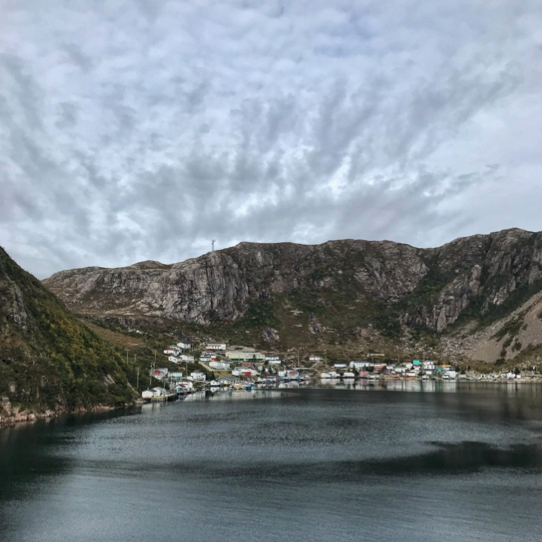
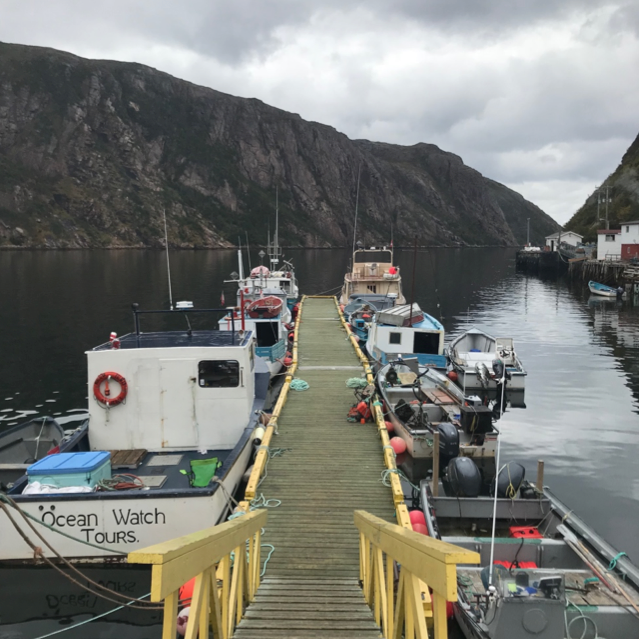
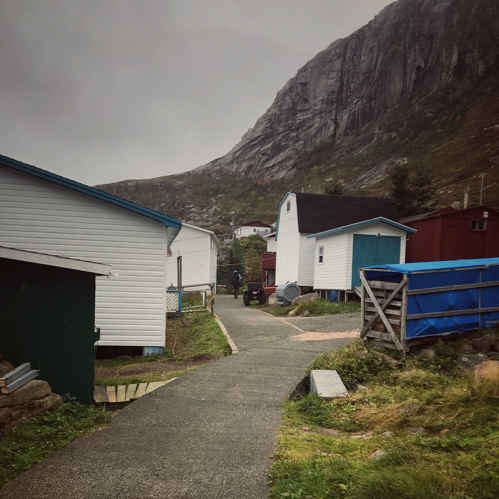
Have you ever been in a town with no cars? No roads for cars? I have been on a few resettled islands in Newfoundland, and one in Fiji… but I mean an active, still on the go, settled town in 2018 with no roads or cars? Anywhere in the world? I really don’t think I had been till my first steps in Francois. What a feeling of stepping back in time.
A living museum to strength and determination of the folks who settled on a rock in the middle of the ocean. Every step in and out of the town is on a groomed, hand-made path of either wood or concrete. I was instantly charmed by their efforts and drive and would take this trip once a month for the rest of my life just to spend a few hours in Francois. I loved it. And not just because we had a wicked dance up in the town hall or because someone has taken over one of the old fishing stages and turned it into a bring your own whisky bar.
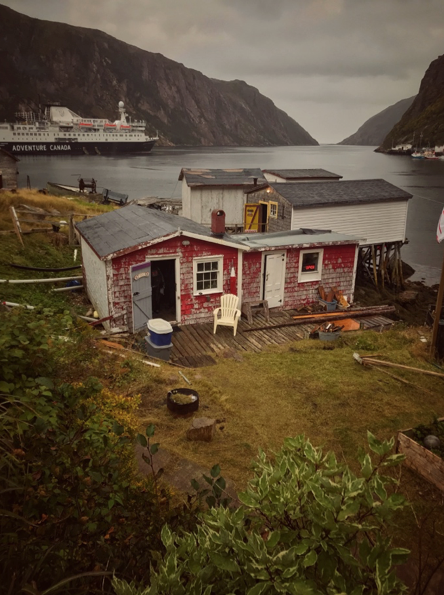
Like Little Bay Islands, resettlement is on the tip of everyone’s tongue here. It’s hard not to think there will sadly come a day soon when this will be a place of summer cottages and have no full-time residents at all. If I thought you should hurry to Little Bay Islands, I insist you hurry to Francois.
Great Big Sea played a gig once in Bay d’Espoir, and as we sailed into the Bay, I confess I was confused where that gig might have taken place. As the zodiac made a beautiful run up Conne River, I was reminded that the gig was on a ball field in Harbour Breton in a different part of the bay. If memory serves, it was in the summer of 1995 and GBS were just signed to a major label and had a music video on TV. We were one of the first local bands to pull this off and were really and truly rising quickly in retrospect. We drove onto a softball field to a festival set up for a few hundred, but a few thousand showed up. The frenzy after the gig was one of the only times I felt endangered as a famous person. The crowd was wild and we had to be escorted out of there like the Beatles or something.
All this to say that I really had no idea what Bay d’Espoir really looked like and was amazed by the wide-open river and how I felt like I was on a completely different planet from the day before. We were just a hundred kilometres or so from Francois, but this waterway was not lined with steep Mordor-like hills. Rather, this river was flanked by high colorful trees that grew right to the water. So much lush landscape bursting with reds and greens and oranges. It looked like we could jump out anywhere and start a vibrant new outpost in a matter of weeks.
Conne River boasts a very impressive reservation. Chief Misel Joe is one of the most impressive people I’ve ever met. He and his team have done an incredible job making this a vibrant and energetic place. Most notably, the school has to be one of the best ones in the province and the students from there are equally impressive. Chatting with them, I could not help but be delighted with their worldly contemporary maturity mixed with their keen respect for the ways of their elders and the past.
I was stoked to be asked to join the drum circle. A real highlight for a wannabe percussionist like myself.

Our last day before we sailed home was our one and only trip to another country.
You probably think I’ve gone cracked. How could we sail to the US or Europe in one day and make it to St. John’s in another? But therein lies the oddity of Saint Pierre and Miquelon, France. Yes. France.
To make a long story short, after a few wars and treaties and such, France opted to keep control of these two Island just off the coast of the Burin Peninsula of Newfoundland. And keep control of them they have. Saint Pierre is within eyesight of what has been Canada for nearing a century. You could be forgiven for assuming that this tiny town of a few thousand must be somewhat decoratively like France but in fact very North American. No one would blame you for thinking surely, they must drive North American cars, and speak mostly English, or keep store and restaurant hours more like Halifax than Marseille.
But they don’t. Not a single little bit.
I often describe Saint Pierre as follows: It is France. Just a few streets of France, but France nonetheless. It is not like France, but actually is France.
You’d think they would fish the same way as fishermen just a few kilometres away in Burin. They don’t. They don’t have the same kind of boats or tie them up the same way.
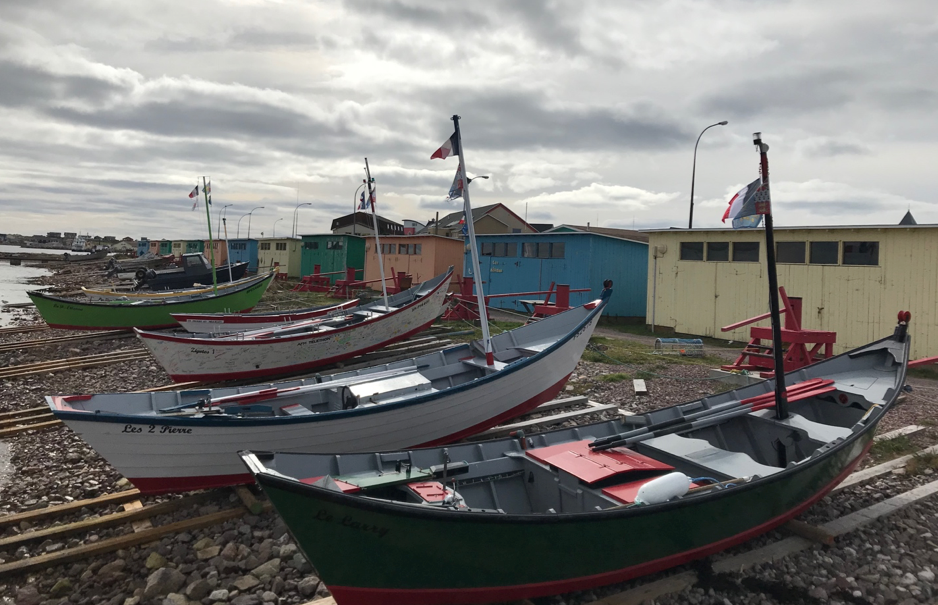
Their lighthouses are different.
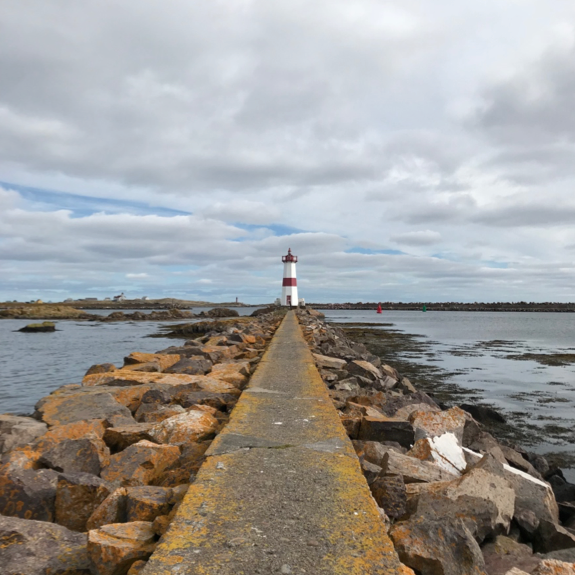
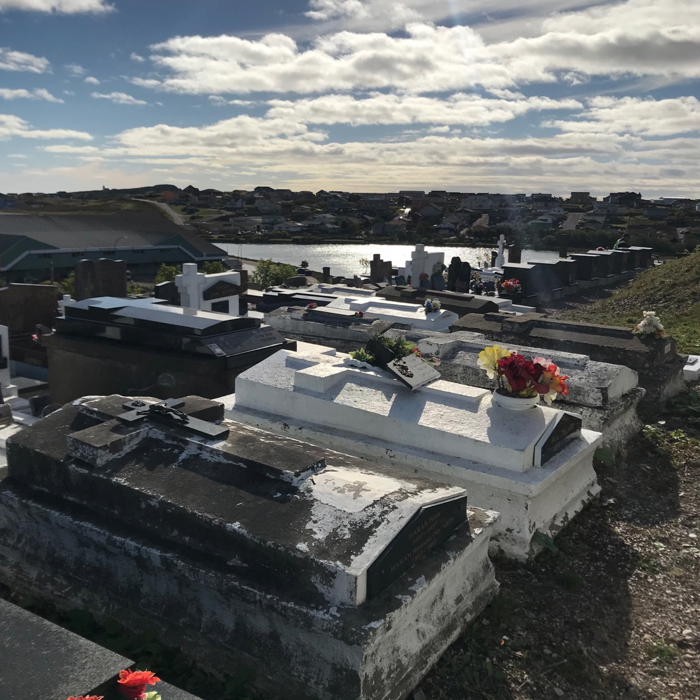
Their shops are different, their meals are different. And yes, even their graves are different.
Saint Pierre is not just like France. It is France. In every way that I could see, hear and taste.
Our last night aboard the ship was jovial to say the least. Like every night, the meals were great and a few drinks in the bar brought out some laughs and eventually a few songs. I think most were surprised to see me head to bed well before the final party stared to roll. I was on a bit of a mission you see. I knew that in just a few hours we would be poised outside the narrows of St. John’s. I have a date with my wife and son to complete the circle and was not about to miss the return.
I lay restless in my bunk and did not sleep much at all. I reflected quickly on some certainties I’d gained over the past ten days. Some I expected. Some I did not.
I did not expect to be so in awe of the landscape of our island. I thought I knew it. I had no idea. I can only imagine the vastness of the Labrador coast which I hope to see soon. I thought I understood the significant role Newfoundland and Labrador had played in the history of the globe in the last 1000 years or so. I really didn’t, in any full and complete way. I still have a ton to learn. I figured I could speak to a rural way of life having grown up in Petty Harbour in the heyday of the inshore cod fishery. But my days in Little Bay Islands and Francois proved me a novice at rural life to say the least.
I also concluded that I live in a very special place. One with a complicated and deep relationship to the land and sea far greater than I would have imagined. The people of Newfoundland and Labrador have become part of Newfoundland and Labrador. We are in it and of it in a way that is unique to here. We walk on it and it feels us. We sail off it and it carries us home. Or doesn’t. We sing of it and it hears us. We eat it and it eats us. We are part of each other and I love that we are.
I rose at dawn just as we passed Petty Harbour, my childhood home. As first light hit Cape Spear, I got some cell service and texted my family. They were waiting and made their way to the same place they’d been ten days ago. The red sun lit the morning sky off the stern, but this sailor took no warning from it.
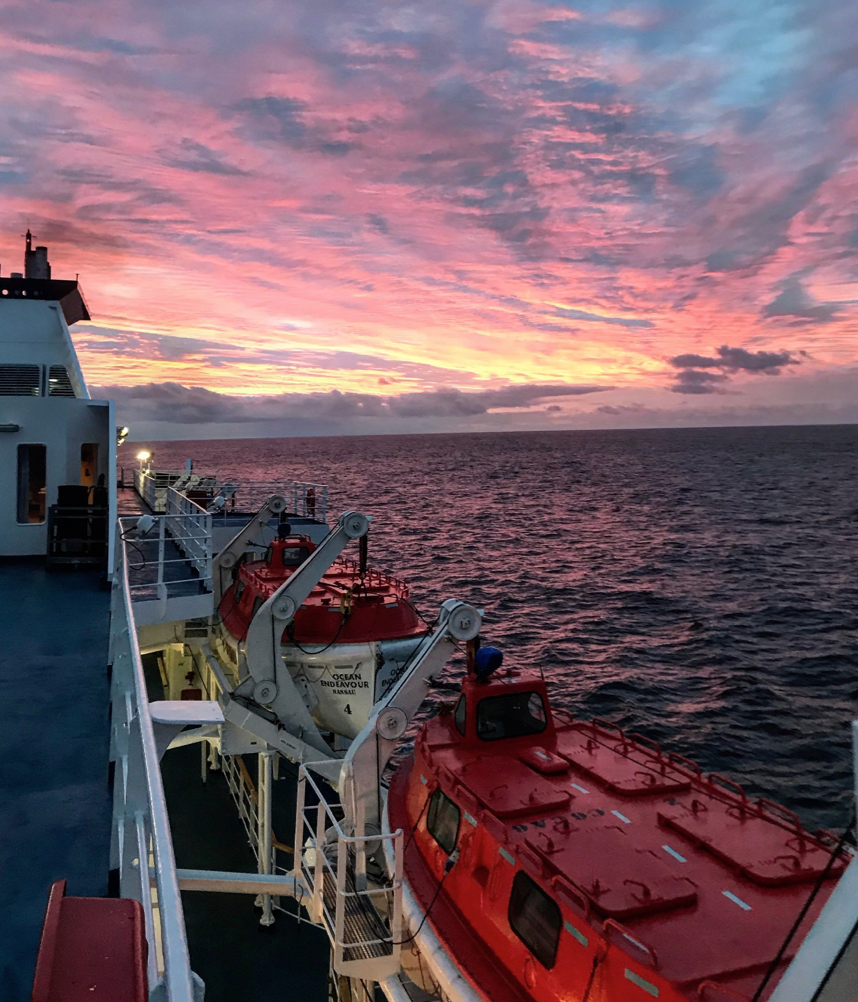
I made my way to the bow and at 7am, we made for the lights of St. John’s Harbour.

I could hear him before I could see him. So could all the others on the deck as Cabot Tower loomed over us. He was almost as excited to see me as I was to see him.
I gathered about 50 passengers and on cue, we all shouted hello to him. He was chuffed.
A wife and a son waving you into St. John’s in all its morning glory. I am the luckiest person I have ever heard of.
The ships horn sounded, and the passengers and crew shouted and celebrated. There were hugs and kisses and thank yous and farewells, but I could only hear one single word.
Home.
